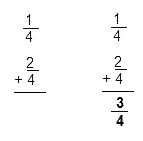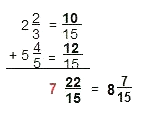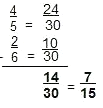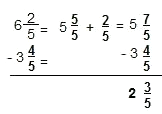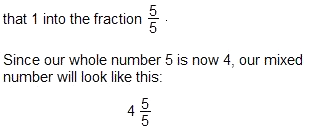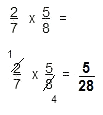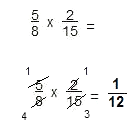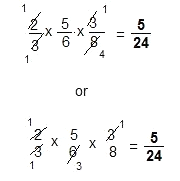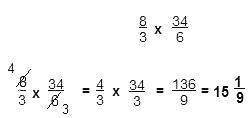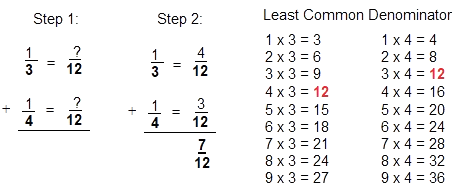Hint: Change the mixed numbers to improper fractions.
To do this, multiply the denominator times the whole number, and then add the numerator as shown below.
Write the 8 as the numerator and leave the 3 as the denominator to create an improper fraction.
Do the same for the second mixed number.
Multiply as usual.
Some Helpful Tools
This section will cover the fundamentals and rules of adding, subtracting, multiplying, and dividing fractions.
Adding Fractions
Below is a quick review of the parts of a fraction:
Example 2: Fractions with answers that are improper, must be rewritten as a mixed number.
Example 1: When adding fractions with like denominators, simply add the numerators.
Example 3: Fractions with different denominators will require finding their least common denominator. In this case, their least common denominator is 12.
Hint: Divide the numerator by the denominator. Then place the remainder on top of the divisor to create a mixed number.
Hint: How many times will 3 go into 12? 4 Multiply 4 x 1. The answer is 4. The first numerator is 4.
Find the second numerator, using the same method.
Add both numerators together. Place that number over the denominator.
Example 4: Mixed numbers can be added together.
Step 1:
Step 2:
Step 1:
Step 2:
Step 1:
Step 2:
Step 3:
Step 2 requires finding a common denominator for both 3 and 5. Since 3 cannot go into 5, multiply the two numbers together. The common denominator is 15.
Step 3 requires changing an improper fraction to a mixed number, and then adding the whole numbers together as shown below.
Subtracting Fractions
Example 1: When subtracting fractions with like denominators, simply subtract the numerators.
Example 2: Fractions with different denominators will require finding a denominator that both fractions have in common. Then subtract the numerators.
Example 3: Subtract a mixed number from a fraction.
Since our answer is not in its lowest term, we will have to reduce. To do this, find the greatest common factor.
Hint: Since we know that our denominator in our mixed number is 5, we will turn our whole number 5 into a mixed number.
To do this, take 1 away from 5, and then turn
Now we're ready to subtract as usual.
Example 4: Subtract a larger numerator from a smaller numerator.
Hint: Since we can't take 4 from 2, we will borrow 1 from our whole number 6, which we will use to create a mixed number.
Add the mixed number to the original fraction, to make the numerator larger.
Subtact as usual.
Multiplying Fractions
Example 1: To multiply fractions, follow the steps below:
- Reduce to lowest terms if possible.
- Multiply the numerators.
- Multiply the denominators.
Step 1:
Step 2:
Step 3:
Step 3 shows how to reduce our answer to lowest terms.
To avoid reducing at the end, see if any reducing can be done in Step 1.
For example:
Hint: Since 2 can go into both 2 and 4, we can divide both numbers by 2.
Then multiply as usual.
Example 2: Multiply the following.
Example 3: Multiply two fractions and reduce diagonally both ways.
Note: Reducing a fraction to lowest terms when multiplying can only be done diagonally.
Example 4: Multiply multiple fractions
Note: Whichever way we reduce, the answer is the same.
Example 5: Multiply mixed numbers.
Step 1:
Step 2:
Dividing Fractions
Example 1: Divide fractions:
- Change the division sign to a mutliplication sign. (Step 2)
- Write the reciprocal of the second fraction. (Step 2)
- Reduce fractions to lowest terms. (Step 3)
- Multiply as usual. (Step 3)
Step 1:
Step 2:
Step 3:
Example 2: Divide mixed numbers:
- Change the mixed numbers to improper fractions. (Step 2)
- Write the reciprocal of the second fraction. (Step 3)
- Reduce fractions to lowest terms if possible.
- Multiply as usual. (Step 4)
Step 1:
Step 2:
Step 3:
Step 4:
Example 3: Divide a mixed number by a whole number:
- Change the mixed number to improper fractions. (Step 2)
- Change the whole number to an improper fraction. (Step 2)
- Write the reciprocal of the second fraction. (Step 3)
- Reduce fractions to lowest terms if possible.
- Multiply as usual. (Step 3)
Step 1:
Step 2:
Step 3:
1st mixed number
2nd mixed number
Math: Operations with Fractions - Tutorial




